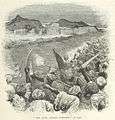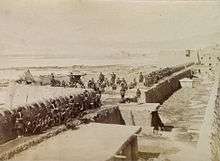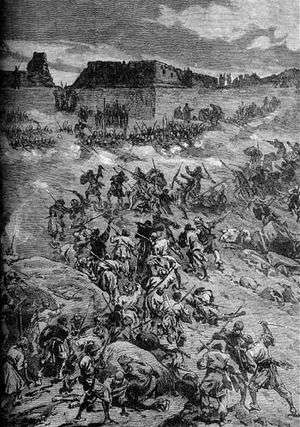Siege of the Sherpur Cantonment
The Siege of the Sherpur Cantonment was a battle fought in December 1879, during the Second Anglo-Afghan War.
Background
On 3 September 1879 Sir Pierre Cavagnari, the British Resident in Kabul, and his escort were massacred by mutinous Afghan troops, initiating the second phase of the Second Anglo-Afghan War. A force was assembled and named the Kabul Field Force, under the command of Major-General Frederick Roberts. After defeating Afghan forces at Chariasab on 6 October, Roberts marched into Kabul on 13 October. At the end of November, an army under the command of Mohammed Jan Khan Wardak, who had denounced Mohammad Yaqub Khan as a British puppet and instead declared Musa Jan the new amir, gathered in the area north of Kabul. On 11 December a small detachment (c.170 men) of the 9th Queen's Royal Lancers and the 14th Bengal Lancers encountered a 10,000+ Afghan army advancing on Kabul.[2] As it was of the utmost importance that Mohammed Jan's advance was delayed the woefully outnumbered Lancers charged the Afghans.[2] Heavy casualties were suffered and the Afghans continued their advance.[2] Anglican chaplain James Adams was awarded the Victoria Cross for rescuing the wounded.
The siege
On 15 December, the Afghan army began to besiege the British forces entrenched in the Sherpur Cantonment. As news of a relief column under the command of Brigadier General Charles Gough reached Mohammed Jan, he ordered his troops to storm the cantonment on 23 December. By midday, the assault had been repulsed, and the Afghan army dispersed. No quarter was given to Afghans found in the area with weapons. The Sherpur Cantonment is maintained up to the present as a British military cemetery.
Order of battle
British Regiments
- 9th Lancers
- 67th Foot
- 72nd Highlanders
- 92nd Highlanders
British Indian Army Regiments
- 12th Cavalry
- 14th Murray’s Lancers
- Queen’s Own Corps of Guides
- 5th Cavalry, Punjab Frontier Force
- 1st PWO Sappers and Miners
- 23rd Bengal Native Infantry (Pioneers)
- 28th Bengal Native Infantry (Punjabis)
- 3rd Sikh Infantry
- 5th Punjabis (Vaughan’s Rifles)
- 2nd Gurkha Rifles
- 4th Gurkha Rifles
- 5th Gurkha Rifles
- 22nd (Derajat) Mountain Battery (Frontier Force)
- 24th (Hazara) Mountain Battery (Frontier Force)
Gallery
 The Afghan forces charge (illustration by Sidney Paget)
The Afghan forces charge (illustration by Sidney Paget) Bengal Sapper and Miners Bastion, in Sherpur Cantonment circa 1879
Bengal Sapper and Miners Bastion, in Sherpur Cantonment circa 1879-8.jpg) View inside the Sherpur Cantonment today
View inside the Sherpur Cantonment today
References
- British Battles: The Second Anglo-Afghan War. Retrieved 2008-10-15.
- A Short History of the 9th Queen's Royal Lancers 1715–1949
- The Afghan Wars 1839–42 and 1878–80 Forbes, Archibald. (Gutenberg Project E-book).
